GATTERs
OF BAVARIA
.
Siedlersreuth
& Poppenreuth (Oberpfalz)
This line first emerges in the records of the Oberpfalz in 1677, with the marriage of Hannes "Gadro", son of Mathes & Anna, shepherds in Seidlersreuth. Subsequent records build up a picture of a large family: Mathes & Anna Gatterer had three sons and four daughters.
According to the old church records these Gatters were migratory shepherds, who herded their sheep for generations in the Oberpfalz region of Bavaria, close to the border with Bohemia (now the Czech Republic. Over the course of two hundred years they slowly spread over an area perhaps 50 miles in diameter, centered on Seidlersreuth.
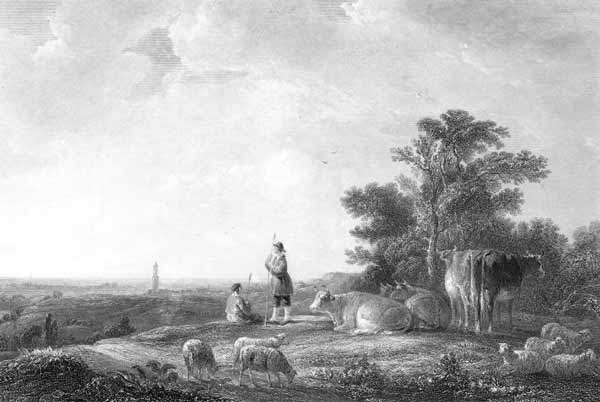 |
They were named Gatter or Gatterer (ones who live by the gate, or outside the city gate), Gaderer, Gauter, Gadro, and Galler. The family name was wildly varied , particularly in the older records. Being a rare name, it was wide open to interpretation, both in spelling and pronunciation, a phenomenon which continues to this day in America. So today one must search the records with imagination: Goderer, Gaiderer, Gottert, Goether, Gatherer, Gader. Over time, the extra -er was dropped from the name, and the family became "Gatter". At least, in most cases .....
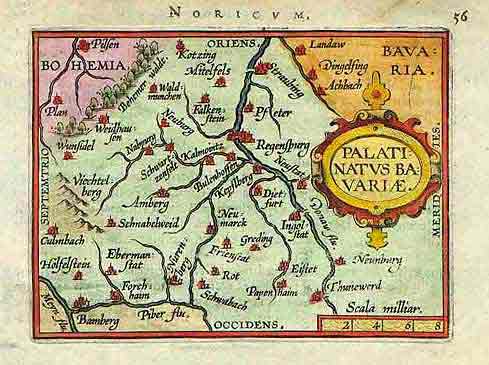 |
|
'Palatinatus Bavariae' - the Oberpfalz region in a map of 1601. The north is to the left in this map and the area of origin of the Oberpfalz Gatters in in the upper left corner bordering the Bohemian mountains. |
Unlike the Irish, who named their children after their parents and themselves, the source of first names in the Oberpfalz was the good friend or relative who stood as godparent. Thus, sometimes the father's name was never passed forward - there is only one Sebastian in the entire family tree, even though he had many children and grandchildren. Other names are repeated over and over, and must have been popular in that time and place, such as Johann Georg and Maria Anna. In many families, every child would have the same first name, either Johann or Maria. Obviously, in these cases the second name was the important name. In the most unusual instances, a godparent would stand twice, and the godchildren, both living, were found to have the exact same first and middle name. There are instances of up to four children with the same name. Between 1765 and 1782, Johann Leonhard Goetter named four children Johann Kasper The first two are presumed to have died young, but the third Kasper, born 1774, lived to have many children. Despite his survival, a fourth namesake was born 8 years later.
Since the church records start almost 100 years earlier, it is presumed that Mathes emigrated from elsewhere, perhaps Bohemia or Austria, at the end of the Thrity Years War in 1648.
The question of where one's family came from is always a big one, and in the case of Mathes and family it is complicated greatly by the Thiry Years War. The Thirty Years War was a conflict over religion that consumed most of Europe, and which decimated and shifted populations in Bavaria and elsewhere. The ebb and flow of reformation and counter-reformation led to mass exoduses and expulsions, conversions and re-conversions. Mathes and his family were likely caught up in one or more of these movements of people; seeking religious freedom, better economic opportunity, or simply, survival.
Since Mathias (or Mathes) is the name of the Catholic Austrian emperor of the day, we know Mathes was both at birth--Catholic and from the south. And the name Gatterer appears in greatest numbers in the Tirolian region, now split between Italy and Austria. Fully two thirds of Gatterers live today in this one area.
Perhaps they were at one time Lutheran, forced to leave Austria between 1567-1620 to escape the Counter Reformation. And finally they would have been forced to reconvert to Catholicism, as the Counter Reformation asserted itself virtually everywhere.
Or perhaps they were steadfastly Catholic, and were welcomed into Catholic Bavaria, to help resettle the devasted towns. Since their entry into the church records is after the War, this scenario seems likeliest.
Mathes had 3 sons, Hannes, Johann and Sebastian. Initially it was presumed, since Hannes is another name for Johann, that Hannes & Johann were one person, who married twice. But it was a case of two children having the same first name. Knowing Johann's age, it could be calculated that he was too young to marry in 1677. Moreover, entries for second marriages always describe the groom as a widower (viduus); and his parents would not be listed in the entry. This is not the case in the marriage of Johann in 1685.
The three sons launched three lines of the family. Johann's family was found south of Tirschenreuth, Sebastian's more to the north and up to the border with Bohemia. Hannes' line is the sketchiest, but is found further and further westward throughout the 18th century, even into the Mittelfranken region. In the 18th century, virtually all of the family were shepherds, and despite the high infant mortality rate, they managed to, if not exactly flourish, to increase and spread across the Tirschenreuth region.. There were perhaps 30 male marriages and second marriages that produced children.
The families, of course, grew apart over time and forgot about the other lines. But there were some intersections. In 1800 Johannes Gatter, of Sebastian's line, married Maria Eva Gatter, of Johann's line. They were fourth cousins. They had a daughter, Eva.
Also, in 1806, 2 Gatter(ers) from the above two lines, also fourth cousins, were soldiers together in the Prinz Ludwig Battalion in the Napoleonic wars. The Prinz Ludwig Battalion engaged the Austrians in Innsbruck in 1809, and one of the Gatterers was cited for bravery in the battle. Both likely did not survive, however, when the Bavarians joined Napolean on his ill-fated foray into Russia in 1812-13. The Battalion was decimated, and few if any returned.
By the mid nineteenth century, more and more members of the family were engaged in work other than herding. Court clerks, carpenters, bricklayers, accountants, furniture-making, tailors, factory workers. The countryside, "outside the city gates" was abandoned for the towns and cities.
By the end of the nineteenth century we also get to witness the curious malleability of the Gatter name. In the early records, the fluctuations of the name can be dismissed as random interpretations of the writer. The records give one individual three different names: Johann Gadro in1685, Gaiderer in 1686, and in 1721,upon dying, Gatterer. By the nineteenth century however, the name always appears as Gatter.
But one branch of Sebastian's line, close to the Czech border, appears from early on in the records as Goetter, Getter, or Goether. As the nineteenth century closes, and the recordkeeping stabilizes, it is clear that their name really has changed, has become Götter - meaning 'Gods' - really another German name altogether.
The last surprise is Hanne's line. Hanne's line appears sparsely in the records, and the name early on is recorded as Goderer, Gotterer, etc,-different, but only rarely without the second -er. In the late records, this line is revealed to have retained the original Gatterer name.
With the advent of German civil records, we are able to track the auswanderers. Cunigunda Gatterer moved from Auerbach to Weikersdorf, near Vienna, where she had a son Johann out of wedlock in 1858. He married, and perhaps there are Gatterers there today. Andreas Gatter, a postman, moved to Dorfen, Erding - not far from Munich, and married. Other members of the Auerbach Gatterer line moved to Munich, Nurnberg and Weiden.
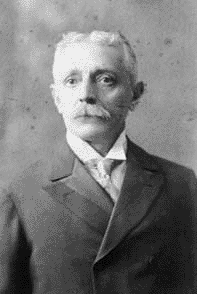 |
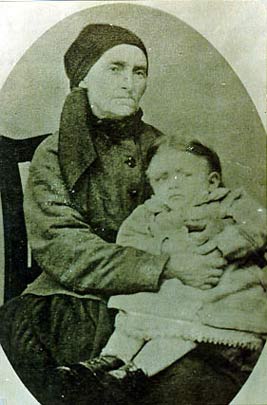 |
|||
|
The
master taylor Franz Joseph GATTER (1851 -1946)...
|
...
and his mother Maria Anna Gatter (born 1820) in around 1880 with
her granddaughter Josephine Francesca Gatter (born 1877) (married
Loef)
|
The Gatter who traveled the farthest was Franz Gatter, tailor, who plied
his trade in Munich and Geneva, and who ultimately traveled across the
Atlantic to New York City in 1879, to start the American line. After ten
years of living in New York City, he moved to Waterbury, Ct., where the
family lived for the next 100 years. Descendents now live throughout New
England, and in the Midwest.
The greatest drama of Franz's life was not his travels, however. He
had a young daughter from a first marriage, who was left behind in Germany
with his mother. He intended for her to follow him over later. Fearing
the voyage and the unknown, she never did, and this in time led to Franz
having German grandchildren as well as American. At the time of the Second
World War, this was a source of great stress. Some of these German grandchildren
had the Gatter name, as his daughter's firstborn son was out of wedlock.
These families lived in Nurnberg and Munich.
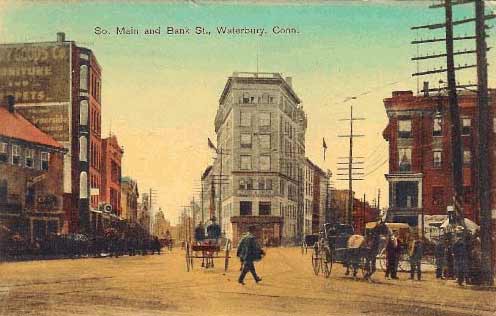 |
|
Here on Waterbury's Bank Street, where Franz Gatter had his taylor shop |
Back in Germany, there are descendents still living in the Oberpfalz, of both Sebastian's and Johann's lines. They live in close proximity to each other, separated by 400 years of time.
Of the Gatterers, after 1850 there is no trace of them anywhere but in Auerbach, near Mittlelfranken. Here a grandson of Hannes had an extremely late second marriage (he was 66), which against all odds leads to the founding of what became a large prosperous family. This family left shepherding behind and achieved burgher status, becoming masons, brewmasters and court clerks. None live in Auerbach today, but as mentioned, they sought out their livelihoods in other cities, and there are descendents living in Munich, and probably elsewhere.
Of the Götters, little is now known. One family lived across the border in Eger, now Cheb, Czech Republic. There was a Thomas Götter married in 1907, and a Karl, married in 1905, with a son, also Karl, born the same year. Karl unfortunately died in World War Two. Presumably there were others in this family, but their whereabouts after World War Two are unknown and not easy to track.
Copyright:
Gatter Archive 2000-2008
Any distribution and use of material displayed on the Gatter History Archive
Web Page
other than for personal purposes will be prosecuted
Contact